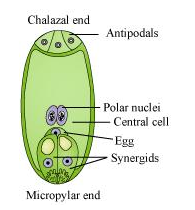With a neat diagram explain the 7-celled, 8-nucleate nature of the female gametophyte.

The female gametophyte (embryo sac) develops from a single functional megaspore. This megaspore undergoes three successive mitotic divisions to form eight nucleate embryo sacs.
The first mitotic division in the megaspore forms two nuclei. One nucleus moves towards the micropylar end while the other nucleus moves towards the chalazal end. Then, these nuclei divide at their respective ends and re-divide to form eight nucleate stages. As a result, there are four nuclei each at both the ends i.e., at the micropylar and the chalazal end in the embryo sac. At the micropylar end, out of the four nuclei only three differentiate into two synergids and one egg cell. Together they are known as the egg apparatus. Similarly, at the chalazal end, three out of four nuclei differentiates as antipodal cells. The remaining two cells (of the micropylar and the chalazal end) move towards the centre and are known as the polar nuclei, which are situated in a large central cell. Hence, at maturity, the female gametophyte appears as a 7-celled structure, though it has 8 nucleate.
Click here to get exam-ready with eSaral
For making your preparation journey smoother of JEE, NEET and Class 8 to 10, grab our app now.
